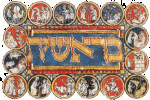Rosh HaShanah—the Beginning of Change I
It’s All in the Name Rosh HaShanah is usually translated as the New Year. When translated literally, it means the “Head of the Year.” In
It’s All in the Name Rosh HaShanah is usually translated as the New Year. When translated literally, it means the “Head of the Year.” In

The spectacle of the universe becomes so much the grander, so much more beautiful, the worthier of its Author, when one knows that a small
A-Series and B-Series as Zman and Seder HaZmanim McTaggart’s series A and series B are two conceptual frameworks proposed by the philosopher J.M.E. McTaggart[1] to
Structurally identical biblical accounts of creation, destruction, and restoration are viewed as a manifestation of dialectic triad thesis-antithesis-synthesis.

And the Eternal G‑d said: “It is not good that the man should be alone; I will make him a helpmate opposite him.” (Genesis 2:18)

And the Lord appeared unto him in the plains of Mamre, as he sat in the entrance of the tent in the heat of the

Time is a storm in which we are all lost. ” (William Carlos Williams, Introduction to “Selected Essays”) I always had a hard time relating

Meditations on the Maaseh Merkavah – IV This is the fourth and the final installment in the series of posts related to Ezekiel’s prophesy, Ma’aseh
(A popular summary of the paper “Towards Futuristic Interpretation of Quantum Mechanics” by Alexander Poltorak being currently prepared for publication) Quantum mechanics (QM) is one

Meditations on the Maaseh Merkavah – I We do science by studying nature. We study physics in a lab, peering into space or working out

In the last post, Tishrei—Past, Present, and Future, we discussed how all Tishrei holidays – Rosh HaShanah, Yom Kippur, Sukkot, and Simchat Torah – are

The months of Tishrei is full of holidays, and they all share a common theme—the unification of time—past, present, and future. It all starts with

The Passover Seder is called seder, i.e., “order” not without a reason. It is a highly structured and orchestrated ceremony that follows the ancient script—Passover
Do you like riddles? Here is a riddle – what do these two figures represent in the context of Exodus? No Idea? How about

There is a continuous thread about the mastery of time that weaves through the last chapters of the book of Genesis (Bereshit) and continues through
Presented at the International Torah and Science Conference in Miami International University on December 18, 2005 Alexander Poltorak Introduction. This is the third in